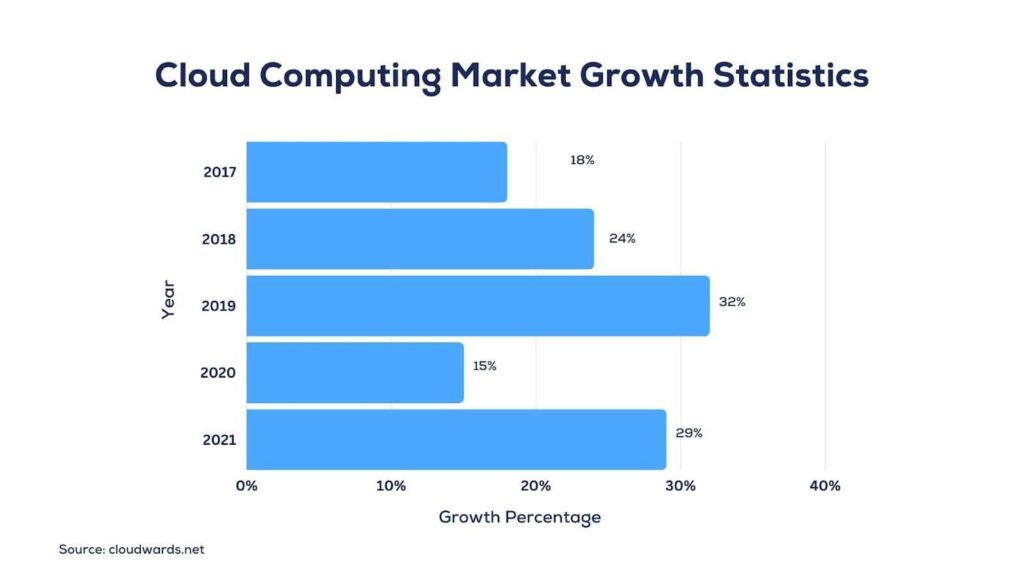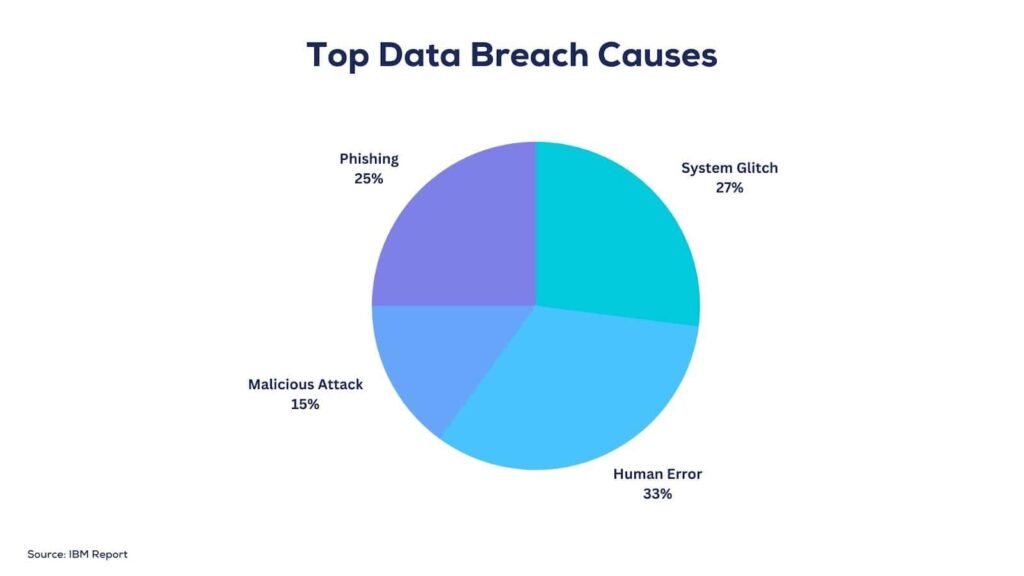
In an era where the digital landscape is rapidly evolving, cloud computing has emerged as a dominant force. And since the COVID-19 crises, the cloud computing market has experienced an unprecedented upward trajectory. With the global cloud computing market valued at a staggering $371.4 billion in 2020 and projected to rise to $832.1 billion by 2025, the importance of effective cloud data governance has never been more pronounced.
While the importance is clear, what exactly comprises effective cloud data governance? Let’s delve into its key components.

The Imperative of Cloud Data Governance
Cloud computing isn’t a monolithic entity; it’s a multifaceted domain with three major types:
- Infrastructure as a Service (IaaS)
- Software as a Service (Saas)
- Platform as a Service (Paas)
Each of these components plays a crucial role in the digital ecosystem. With a whopping 94% of all enterprises leveraging cloud services in some capacity, understanding the intricacies of each component becomes paramount.
The ubiquity of cloud services makes establishing robust policies, procedures, and standards for effective data management across organizations more critical than ever. By implementing data governance best practices, companies can effectively manage the accessibility, functionality, accuracy, and protection of their cloud-stored data.
However, as with all technological advancements, there are challenges to navigate. Let’s explore the hurdles organizations face in implementing robust cloud data governance.
The Business Significance of Cloud Data Governance
The digital realm, while abundant with opportunities, is not without pitfalls. Cloud services, despite myriad benefits, are constantly under threat of cyberattacks targeting personal and corporate data. Yet, it’s not just external threats organizations need to be wary of. A surprising 88% of breaches attribute to human error, underscoring the need for vigilance and comprehensive training.
Understanding the challenge is half the battle. The next step? Strategizing for effective cloud data governance. Let’s dive into the best practices and strategies guiding organizations toward seamless cloud data management.
Compliance: Meeting regulatory requirements concerning data privacy and security is crucial. With tightening regulations around consumer data, having proper governance ensures continuous compliance.
Risk Management: Mitigating risks related to data breaches, data loss, and unauthorized access is pivotal in cloud landscapes. A breach can have disastrous effects on an organization’s reputation and bottom line.
Data Quality: Ensuring data accuracy and consistency for informed decision-making is key. Erroneous or inconsistent data leads to ill-advised choices that negatively impact businesses.
Collaboration: Facilitating interdepartmental collaboration through common data management frameworks fosters alignment. With various teams on the same page, organizations can drive strategic initiatives seamlessly.
When challenged, forward-thinking organizations pivot and adapt. With 92% of organizations adopting a multi-cloud strategy, it’s evident versatility and adaptability are key. Yet, the strategy isn’t solely about diversification. For five consecutive years, cloud cost optimization has topped the priorities, with 61% of organizations aiming to optimize cloud costs in 2021. This underscores the importance of not just using the cloud, but using it wisely.
As we navigate the ever-evolving digital landscape, effective cloud data governance emerges as a beacon, guiding organizations toward security, efficiency, and growth. By understanding its importance, components, challenges, and strategies, businesses can harness the full potential of the cloud, ensuring a brighter, more secure digital future.
Core Principles of Cloud Data Governance
Effective cloud data governance rests on six core principles that guide policies, procedures, and standards:
- Accountability: Assigning responsibility for data management ensures policies are enacted. With stakeholders accountable, compliance improves.
- Transparency: Clearly defining and communicating data management policies organization-wide fosters collaboration. Ambiguity leads to misalignment.
- Accessibility: Ensuring data availability while safeguarding sensitive information protects businesses. Striking the right balance is key.
- Integrity: Maintaining data accuracy, consistency, and reliability is paramount. Flawed data cripples organizations.
- Security: Implementing robust measures to protect data from unauthorized access or breaches is pivotal given rising cyber threats.
- Compliance: Adhering to regulatory requirements and industry standards is non-negotiable in today’s privacy-focused climate.
- Collaboration: Promoting interdepartmental consistency in data management keeps everyone on the same page. Eliminating silos drives strategic initiatives.
With these principles guiding policies and processes, organizations can implement cloud data governance that meets both internal and external mandates seamlessly.
Challenges in Implementing Cloud Data Governance

While crucial, establishing effective cloud data governance comes with hurdles, such as:
- Addressing data complexity: The increasing volume, variety, and velocity of data in the digital age pose challenges. Harnessing massive, heterogenous datasets spread across complex cloud environments becomes an arduous task.
- Ensuring data quality: With data flowing in from multiple internal and external sources, errors, duplications, and inconsistencies can creep in, compromising data reliability. Rigorous quality control is essential.
- Overcoming data privacy and security concerns: Cloud environments can be vulnerable to breaches and unauthorized access despite stringent measures by providers. Addressing these concerns is paramount for organizations.
- Navigating compliance challenges: In multi-location cloud storage scenarios, regulations vary across regions. Keeping abreast of changing compliance requirements in different locations is critical yet challenging.
- Managing organizational and technical complexities: Data governance encompasses everything from structuring accountability to implementing the right solutions. Navigating these nuances while driving adoption can be challenging.
- Determining data ownership: In collaborative cloud environments with data flowing cross-departmentally, determining authoritative ownership and accountability can get convoluted.
Organizations face multifold challenges ranging from the growing scale of cloud data to unraveling compliance complexities in the cloud. By acknowledging these roadblocks, they can craft targeted strategies to overcome hurdles on the path to robust governance.
Distinguishing Cloud Data Governance from Compliance
Cloud Data Governance
Involves establishing policies, procedures, and standards focused on managing a cloud-based data estate. The key goals are ensuring data quality, security, integrity, accessibility, and usability to derive value. It is an internally driven process centered around an organization’s specific needs and cloud infrastructure.
Compliance
On the other hand, it focuses on adhering to external mandates like regulatory requirements, industry standards, and regional data sovereignty laws. it aims to avoid penalties by meeting prescribed guidelines. While aligned, governance and compliance differ in their core motivations and scope.
However, in dynamic cloud environments, the line can blur. Continuous compliance becomes contingent on vigilant governance strategies that ensure cloud resources and data adhere to evolving regulations. Integrating automated compliance controls into the governance framework is key.
Sound data governance practices provide the foundation for fulfilling compliance needs. Viewing governance and compliance as interconnected yet distinct enables organizations to craft targeted strategies that check both boxes effectively. A balanced approach is optimal for the cloud.
Streamlining Cloud Data Governance with Modern Tools
The complexities of the cloud make manual governance impractical. Modern platforms like BigID enable organizations to efficiently steward data across multi-cloud and hybrid environments. With AI-powered discovery, classification, and protection, they provide complete visibility and management.
Additionally, leveraging machine learning delivers actionable insights that can drive governance strategies. Automated retention policies based on machine learning models further help reduce data risk and ensure compliance.
Overall, integrating smart solutions paves the path toward robust, automated governance that evolves continually alongside changing cloud landscapes and regulations.
Frequently Asked Questions
How does cloud data governance differ from traditional data governance?
Cloud data governance focuses on managing data across the cloud’s complex, distributed environments involving multiple providers rather than centralized on-premise infrastructure.
What are the potential risks of not implementing robust cloud data governance?
Lack of governance can lead to non-compliance, data breaches, inconsistencies, unauthorized access, and poor decision-making due to inaccurate data.
How can organizations ensure continuous compliance in dynamic cloud environments?
Regularly tracking regulatory changes, updating policies promptly, deploying automated compliance controls, and leveraging AI-based platforms enable maintaining continuous compliance.
Summing Up
- Effective cloud data governance is pivotal in today’s data-driven world, with the cloud market booming. It encompasses managing accessibility, functionality, accuracy, and protection of data.
- Core principles like accountability, transparency, accessibility, integrity, security, compliance, and collaboration are fundamental to governance frameworks.
- Organizations face challenges like data complexity, privacy concerns, and compliance management.
- Therefore, leveraging AI-powered modern platforms helps streamline cloud data governance and ensures continuous compliance.
By deploying solutions that provide complete visibility and intelligent automation, organizations can harness the cloud’s potential securely and compliantly. Robust data governance practices are the key to excelling in the digital era.
Last Updated:
Article written by Sam Darwin.




![How to Start a Freelance Copywriting Business [10 Steps]](/wp-content/uploads/2023/01/Starting-a-Freelance-Copywriting-Business.png)